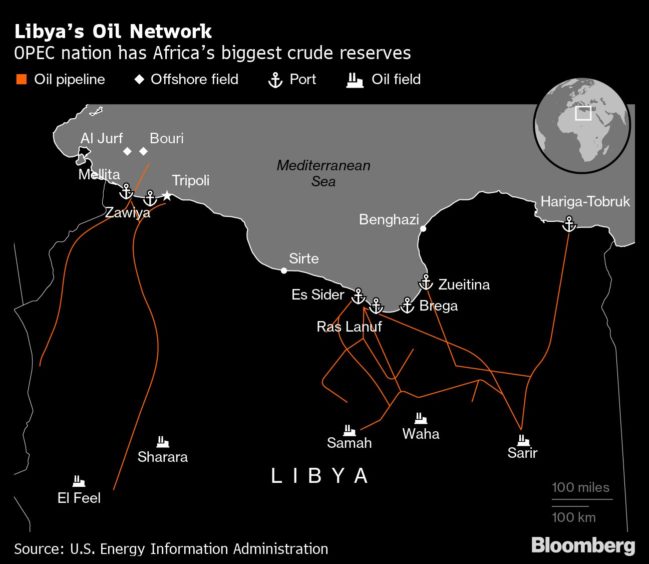
Libya’s oil industry continued to revive this week following a truce between the main factions in the OPEC member’s devastating civil war.
The Sarir field opened on Tuesday, according to its operator, Arabian Gulf Oil Co. Production is just 30,000 barrels a day for now.
But with a capacity of about 200,000, it’s the biggest deposit in the country to restart since an almost-total shutdown of Libyan energy facilities in January.
Much of the country’s “oil crescent” — a cluster of ports and fields in the east — is back onstream, though not yet at full capacity.
Libya’s western fields, including Sharara, the biggest in the North African nation, are still closed.
The state-run National Oil Corp. has said foreign mercenaries and other fighters must leave facilities before than can reopen.
Overall oil output has reached about 300,000 barrels a day, up from 80,000 at the start of September.
Libya has seen false dawns before, and previous deals to stop the conflict have quickly collapsed. But if this one holds, JPMorgan Chase & Co. forecasts that production can hit 1 million barrels a day by March.
The potential for extra Libyan supplies is putting pressure on oil prices just as traders fret about the outlook for energy demand with the coronavirus pandemic still raging. Brent crude is down 3.5% this week to around $40.50 a barrel, increasing its loss this year to almost 40%.
“The increase in Libyan oil production is promising after so many months of deadlock and billions of dollars lost,” said Kristoff Potgieter, an analyst at NKC African Economics in South Africa. But the higher output will “be eyed warily by OPEC as it attempts to restrict production and stabilize prices.”
Here’s the latest on Libya:
Arabian Gulf Oil Co., or Agoco, has also restarted the eastern fields of Messla, which is producing 67,000 barrels daily, and Hamada, which is pumping 6,000.
Fields supplying the eastern ports of Brega, Hariga and Zueitina were pumping 150,000 barrels a day as of Sunday, according to two people with knowledge of the situation.
Production will continue to rise as more tankers arrive and load crude from storage, creating room for fresh oil from the fields, they said.
The east’s two other oil ports — Es Sider and Ras Lanuf — are sill closed.
Sirte Oil Co., which runs Brega and some fields, is pumping close to its normal level of 70,000 barrels a day; it has also restarted its refinery.
Last week, two tankers each shipped one million barrels from Hariga.
A tanker is expected at Zueitina next week to load 630,000 barrels. Another vessel, a Suezmax tanker with capacity for one million barrels, is due there later in October. The port has more than 4.5 million barrels in storage.
Libyan ports have around 24 million barrels in storage, with almost 20 million of those in eastern terminals, analysts at OilX said last week.
What else to watch:
Sharara can pump 300,000 barrels a day. It’s run by the NOC in a joint venture with France’s Total SE, Spain’s Repsol SA, Austria’s OMV AG and Norway’s Equinor ASA
The nearby El Feel field, in which Eni SpA of Italy has a stake, is also shut down
Brega port is expected to load three crude cargoes in October of 600,000 barrels each, according to an initial loading plan
Below is a list showing the status and capacity, in barrels a day, of Libya’s oil export terminals, according to data compiled by Bloomberg:
Es Sider, Closed, 340k; force majeure
Zawiya, Closed, 230k; force majeure
Ras Lanuf, Closed, 220k; force majeure
Mellitah, Closed for crude, 160k; open for loading condensates
Hariga, Open, 110k
Zueitina, Open, 70k
Brega, Open, 60k
Offshore terminals:
Bouri, Open, 45k
Jurf, Open, 40k